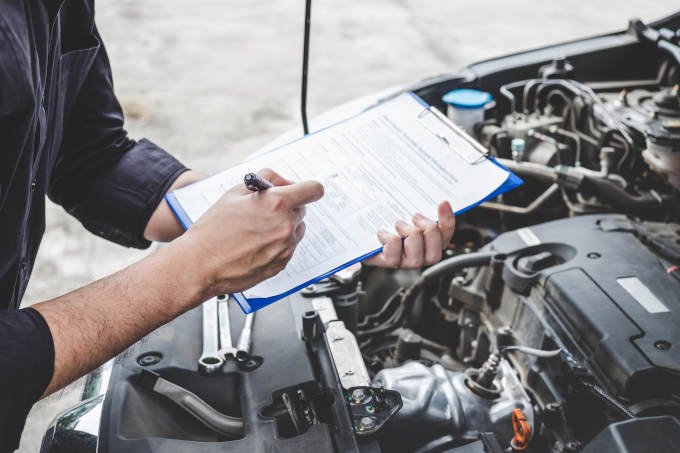There are several essential maintenance milestones for your vehicle. One is the 100,000-mile mark. Many see the odometer turn to six figures with a certain amount of trepidation, thinking that they might be nearing the end of their time with their vehicle. If you stick to the proper maintenance guidelines, there’s no reason at all that your car shouldn’t go well beyond 100,000 miles.
Most Important Maintenance at 100,000 Miles
Here is a list of common items you should consider checking when your car reaches 100,000-miles. Always check your vehicle owner’s manual and consult with a professional technician to determine what is appropriate for your specific vehicle make and model.
1. Timing Belt
As the name suggests, this component is about keeping the timing and synchronicity of your car’s engine in check. Without it, your engine quickly descends into chaos, and serious and expensive issues can result.
If you have made it to 100,000 miles without changing your timing belt, the time has come to change it. No manufacturer recommends using a timing belt beyond 100,000 miles. The potential damage done to your engine without replacing it could be much more severe and costly, possibly even irreparable.
Newer cars and most luxury models like BMW and Mercedes are fitted with a timing chain rather than a timing belt. In most cases, the timing chain is expected to last the life of the vehicle and does not require replacement at 100,000-miles. To check whether your car has a timing belt or chain, ask a trusted mechanic or consult your owner's manual.
2. Water Pump
The water pump is essential for the proper working of your vehicle’s cooling system. It pumps both coolant and water into the engine to prevent dangerous overheating. The water pump is operated by the drive belt, which helps move the blades that drive coolant to the engine. Unlike some other components in your vehicle, the water pump may fail without any warning. That’s just another reason to get it swapped out if you haven’t done it already at 100,000. Malfunctions in your pump could start with leaks but evolve into more serious issues, such as expensive repairs or failure.
3. Fluids
Your vehicle’s transmission fluid, brake fluid, transmission fluid, and coolant should be inspected during your 100,000-mile maintenance check to determine their condition and if they need to be topped off or changed. Be sure to follow your vehicle’s maintenance schedule and service interval record for proper fluid maintenance recommendations.
All of these fluids play a crucial role in the health of your vehicle’s functionality:
- Engine oil lubricates the many moving parts and is essentially the lifeblood of your engine.
- Transmission fluid keeps the intricate and interconnected parts of your transmission running smoothly to avoid premature wear on what is a very expensive core system to replace.
- Brake fluid and power steering fluid both accumulate moisture over time and become less effective at transmitting power to the brakes and keeping your vehicle’s steering easily controllable.
- Coolant has a dual purpose: it prevents your engine from overheating in hot weather and freezing solid in frigid weather. An overheating engine is of particular concern since it can quickly cause catastrophic engine failure.
4. Brakes
A typical vehicle will need new brake pads every 40,000 to 50,000 miles, so at 100,000 miles it is very likely you will need new brake pads. The brake pads are designed to warn you when they are running dangerously close to their 2/32 of an inch minimum safe thickness by releasing a squeaking noise when applied.
You can inspect the state of your brake pads yourself by looking through the gaps in your alloy wheels and regarding the current thickness of the brake pads. If you haven’t cleaned the area in a long time, another problem can be brake dust buildup. A proper service, cleaning, and fresh brake pad installation will get you back on track in no time at all.
5. Tires
In general, a set of tires with proper rotation every 7,500 miles or so should last for about 25,000 - 50,000 miles, depending on the brand, quality, and thickness of the tire tread when new. It also depends on how you drive. If you like fast acceleration and sharp braking, then your tires may wear out more quickly than on the average vehicle.
At 100,000 miles, you’ll undoubtedly be due for tires, or perhaps a rotation if you just had them changed at 85,000 - 90,000 miles. In any event, this milestone will certainly see attention being paid to your tires.
6. Exhaust System
When you hit 100,000 miles, the likelihood that you start to hear some rattling or other unsavory sounds from the exhaust increases. That’s just the result of general wear and tear over time. Typical issues include things like exhaust buildup, minor holes and leaks, and possibly some hairline cracks. It depends as much on the kinds of environment that you drive in as it does the mileage.
When your exhaust passages are blocked by buildup or have even minor structural damage, the engine has to work harder to compensate and maintain power. A thorough cleaning at 100,000 miles is usually enough to get things working again, but you may also have to face more expensive repairs on your catalytic converter and oxygen sensors.
Vehicle Maintenance Is an Investment
It seems somewhat counterintuitive to invest in a depreciating asset like a vehicle. However, if you either want to keep your ride for years to come or sell it for a reasonable price somewhere down the line, then keeping it well maintained is essential.










